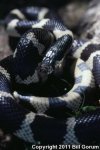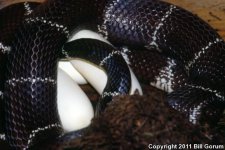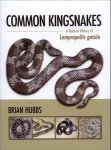| Range: |
 In New Mexico, the known range includes the San Juan River in San Juan County, to approximately five miles east of the Arizona state line, but the snake may occur along tributaries in the immediate vicinity. California Kingsnake morphs may also be found in part of the Gila River drainage in the southwestern portion of the state, although this likely an integrade zone with the Desert Kingsnake (L. g. splendida) and individuals resembling each subspecies have been found close to the border in Arizona. Because the snake is found in the drainage of the Little Colorado at St. Johns, Arizona there is also a possibility that it follows the Zuni River from Arizona into Cibola and McKinley counties in western New Mexico. In New Mexico, the known range includes the San Juan River in San Juan County, to approximately five miles east of the Arizona state line, but the snake may occur along tributaries in the immediate vicinity. California Kingsnake morphs may also be found in part of the Gila River drainage in the southwestern portion of the state, although this likely an integrade zone with the Desert Kingsnake (L. g. splendida) and individuals resembling each subspecies have been found close to the border in Arizona. Because the snake is found in the drainage of the Little Colorado at St. Johns, Arizona there is also a possibility that it follows the Zuni River from Arizona into Cibola and McKinley counties in western New Mexico. |
| Other Names: |
Common Kingsnake, Banded Kingsnake, Cal King |
| Description: |
Adults range between 24"-51" in length, though some individuals are larger. Snakes are black and white banded, the width of bands varies, with some individuals having thicker black bands and others having thicker white bands. There are several different morphs found throughout their range including striped individuals, the animals in New Mexico are not likely striped, but banded. |
| Similar Species: |
Longnoses can sometimes lack red coloring and look similar. Their noses are longer and they have white flecking in their black bands. |
| Venom: |
None |
| Habitat: |
In New Mexico, the only known habitat seems to be a Cottonwood-Russian Olive grove within 100 feet of the San Juan River. |
| Behavior: |
Spend most of their time underground. Nocturnal in the summer, an individual was encountered crossing the road in southern Colorado during the late afternoon in late May. can be found under cover in the spring and fall. |
| Hibernation: |
Hibernates during the cool months, likely underground deep in rodent burrows. |
| Reproduction: |
Mates in the spring, eggs are laid approximately 30 days later and then hatch approximately 60 days after that. |
| Diet: |
Constrict their prey of rodents, lizards, birds and snakes, including rattlesnakes. |



















